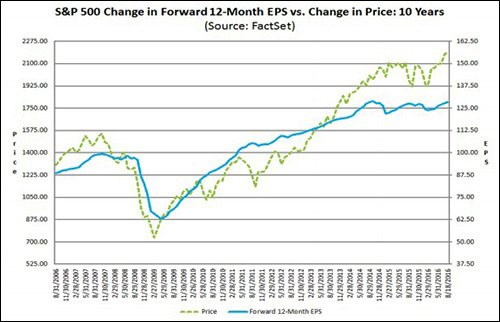By Pam Martens and Russ Martens: August 25, 2016
On July 25, during the opening night of the Democratic National Convention, Senator Elizabeth Warren made the following comments during her speech:
“Here’s the thing: America isn’t going broke. The stock market is breaking records. Corporate profits are at all-time highs.”
We noted at the time that Senator Warren is one of the smartest members of Congress; a former Harvard law professor who taught commercial contracts and bankruptcy law; a member of the Senate Banking Committee and its Economic Policy Subcommittee.
If Senator Warren was not aware that quarterly earnings on a year-over-year basis as measured by the largest companies in America – the Standard and Poor’s 500 – were on track to log in their fifth consecutive quarterly decline in earnings, how could the average American possibly know this?
Equally important, if the stock market was setting new highs based on a prevailing misconception among investors that corporate earnings were still climbing, shouldn’t responsible media be setting the record straight? Or is it the job of corporate media to keep investors ignorant of the economic realities in the U.S. because it might hurt their own publicly traded stock prices?
We decided to see if Senator Warren could have possibly been misled by the so-called “paper of record,” the New York Times. The Times has a nifty search tool that allows one to set a customized time period for searches. We set our time period to search between January 2, 2015 through August 25, 2016. We searched under profit recession. Next we tried corporate earnings. Then we tried S&P earnings. And, finally, we searched under Standard and Poor’s earnings.
We could find no article at the New York Times, much less a headline, that gave any clue to its readers that S&P 500 earnings have been in decline for the past five quarters.
We did find a very misleading headline that appeared in the New York Times’ print edition on the second page of the Business Section on July 21, 2016. The headline reads: “Wall Street Edges Into Record Territory as Earnings Cheer Traders.” This was a rerun of a July 20 article by the Associated Press which had originally titled it “Wall Street Gains as Earnings Cheer Traders.”
One might be forgiven for reading that New York Times headline and thinking that corporate earnings were going in the same direction as the stock market. It wasn’t until the fifth paragraph that there was a hint of a divergence: “Companies are in the middle of telling investors how much they earned in the spring, and analysts are forecasting yet another decline from levels at this time last year. The low expectations have made it easier for companies to come in above forecasts.”
Why is it excruciatingly important for investors in the stock market to keep tabs on the trend in S&P 500 earnings? As Bloomberg’s Lu Wang noted on March 30, 2015, “earnings contractions of three quarters or more have triggered bear markets 82 percent of the time over the past eight decades.”
An eighty-year record is not one investors should ignore – even if companies are gobbling up their own stocks in multi-billion-dollar buybacks financed with cheap debt and central banks around the world have made the deeply misguided decision to use taxpayer money and buy publicly traded stocks or Exchange-Traded Funds (ETFs).
According to FactSet, with 95 percent of S&P 500 companies having reported earnings for the second quarter of 2016, the earnings decline for the S&P 500 for the second quarter of 2016 versus the second quarter of 2015 is -3.2 percent. FactSet doesn’t beat around the bush about it or bury the negative news deep down in its reporting. It gets right to it with this:
“The second quarter marks the first time the index has recorded five consecutive quarters of year-over-year declines in earnings since Q3 2008 through Q3 2009.”
The third quarter of 2008 through the third quarter of 2009 was the worst economic period since the Great Depression, one should carefully recall.
And that’s just the part of the iceberg one can readily see above the water. According to FactSet data, there is negative breadth in 6 of the 10 sectors measured as of June 30. While energy is the key villain with a stunning 83.8 percent year-over-year decline in the second quarter, the following additional sectors were also negative: Consumer Staples, Information Technology, Industrials, Financials and Materials.
There’s an important lesson to take away from this. The New York Times may be the fattest paper in the U.S. but that doesn’t necessarily mean it’s telling you what you need to know to survive financially. In fact, could we have the greatest wealth and income inequality since the 1920s if the New York Times had been hammering away on what Americans need to know?
Related Articles:
Even When Bernie Sanders Wins, He Loses at the New York Times
New York Times Pushes False Narrative on the Wall Street Crash of 2008
New York Times’ Event Headlines Its Writers With Wall Street Honchos
How the New York Times Hides the Truth About Wall Street’s Catastrophic Misdeeds
Pigs Are Flying on Wall Street – Can Glass-Steagall Be Far Behind


